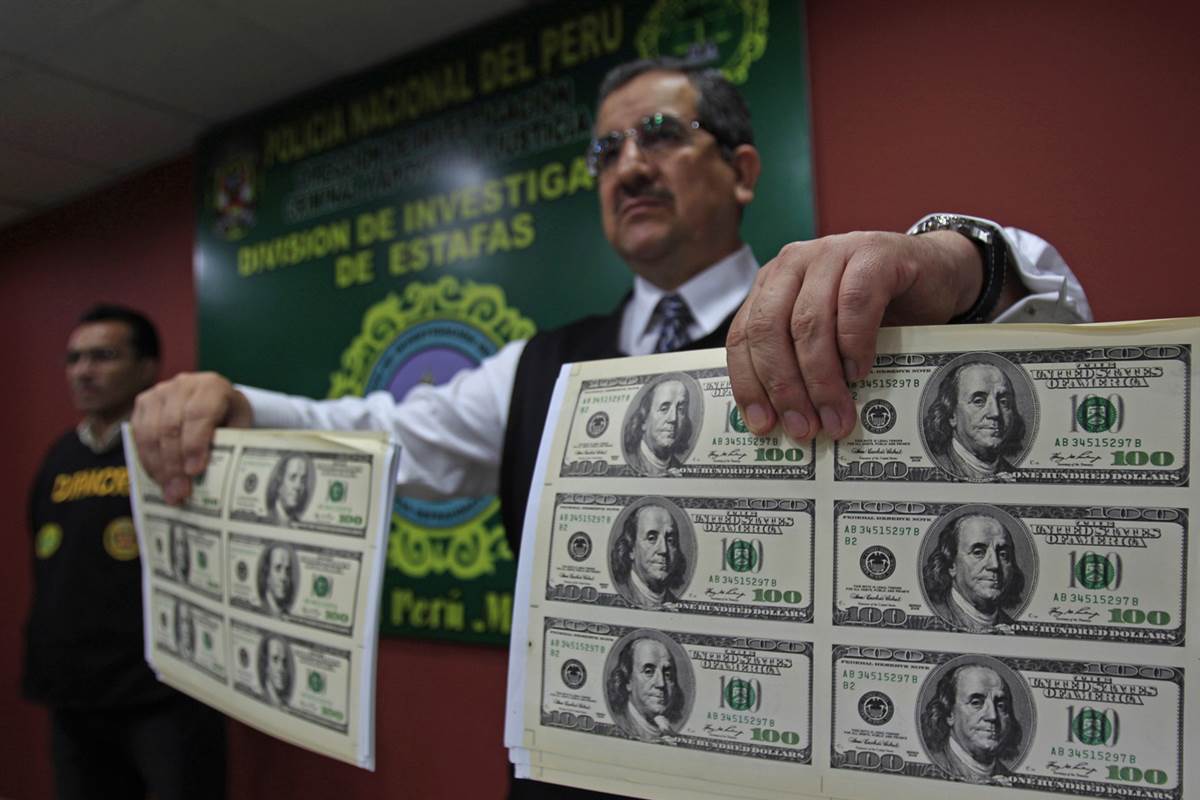Martin Mejia/AP
By
Ricardo Swire
Counterfeiting is considered the ultimate technology for people who want something for nothing. During the past ten years more than US$103 million in fake US dollars “made in Peru,” were seized in law enforcement operations. On November 15th Peru’s Anti-Counterfeiting Task Force, a combined American/Peruvian law enforcement team, confiscated a historic US$30 million worth of imitation currency after a single mission.
One thousand five hundred National Police of Peru officers, in concert with US Secret Services agents, staged “Operation Sunset” which targeted Peru’s capital Lima. The execution of fifty-four search warrants also discovered €50,000 in bogus bills and an undisclosed quantity of fake Peruvian Soles. Nine offset printers, one thousand six hundred printing plates and photographic negatives of different currency denominations were confiscated. According to US Secret Service data, Peru is the world’s leading counterfeit currency producer.
Computer programs, such as Corel Draw or Microsoft Office, are utilized to create templates. Photolithography or etching of metal plates, offset printing and finishing follow. A sheet of imitation bills is lightly coated with varnish, twelve individual bills cut from one sheet. Security strips are inserted with needles and affixed with glue, applied through a medical syringe. The bills pass through an “enmalladora” or netting machine, a piece of equipment, comprised of two rollers covered with coarse fabric, which gives counterfeit currency a rough surface. The notes are then smoothed with fine sandpaper.
Genuine Peruvian Sol banknotes combine the latest international security features of modern currency. The money also showcases Peru’s rich cultural patrimony. National Police of Peru reports confirmed that counterfeiters, utilizing a bleaching process, remove the Sol’s national hero portrait. Re-using the paper an artist applies Benjamin Franklin’s face to create a look-a-like US$100 bill.
The “feel of money” comes from three different things that make currency paper special. Regular A4 or 8 1/2 x 11 printer paper is made from tree fiber. Genuine currency is comprised of cotton and linen strands or “rag paper,” small blue and red fibers mixed in when the paper is manufactured. Inkjet and laser jet printers are unable to perform passable reproductions.
Peru’s fraternity of counterfeiters’ innovation is demonstrated by their application of a yellow highlighter to add color to fake bills. Such creativity mimics an authentic US note’s “security fibers,” designed to glow under ultraviolet counterfeit detection machines. Forgers also use pushpins to perforate newly printed bogus bills. The technique creates a representation of raised letters, similar to genuine currency.
Illegal printing is conducted inside prefab houses, in Peru’s northern hills, late at night. Made for export, finishing touches are the highest quality. Peruvian counterfeiters only need four to five days to make US$300,000 worth of bogus bills. The “Factory” produced currency goes to underworld connections in Lima, some directly smuggled to Argentina, Ecuador and Venezuela. Peru’s underground industry generates substantial profits.
Criminal gangs find imitation money cheaper to produce than cocaine. After expense deductions the counterfeiters earn US$20,000 bona fide currency, for every US$100,000 worth of fake bills made. A regular customer, who purchases US$10,000 or US$15,000 worth of fake bills, pays twenty percent of the value. First timers shell out twenty-five percent for similar amounts. One US$100 counterfeit note retails for US$20.
Trafficking patterns emphasize that every month cash couriers or “Burriers” depart Jorge Chavez International Airport for Mexico. The commercial airline passengers smuggle counterfeit US$100 bills inside hollowed out books, shoe soles and picture frames. Some swallow the currency, rolled up in latex, for intestinal journeys. As a routine counter detection protocol Peruvian Burriers use clandestine Mexican entry points to arrive in America. Airports in the US utilize state of the art security technology that discourages Burriers’ direct travel.
Peruvian nationals, living in Mexico or “Coyotes,” also traffic large sums of imitation cash over the Mexico/US border. The fake money enters financial systems in Texas and California. “Los Nique” and other professional Peruvian counterfeiters only ship fake US$100 notes to America, US$10s and US$20s sent to regional neighbors. In 2012 Peru’s “Wilfredo Cobo” counterfeiting syndicate strategically managed brothers based in Italy, Spain and France who introduced counterfeit Euros to Europe. The fake money was routed through Chile and South Africa.
One March 2016 record profiled an expert counterfeiter. His specialty is distribution of multiple sheets of fake US$100 notes. For the last five years the counterfeit specialist functioned as de facto boss of one of Peru’s four major counterfeiting organizations. He creates his three feet long two feet wide works from a prison cell. Each methodically crafted counterfeit print uses relevant ink types. The prisoner’s service fee is a percentage of each produced US dollar bill. His family act as go-between, facilitating business deals and exchanges.
Records also highlighted a counterfeiting veteran of twenty years, whose syndicate actively creates between US$3 million and US$5 million in bogus US$100 notes weekly. He utilizes a section of co-conspirators. One member operates the offset printer, another does the artwork, someone sources paper and inks, while cutting, surveillance and packer duties are also assigned. Statistics suggest this group alone earns US$600,000 per week. It has the capability to deliver a US$5 million order seven days later.



No Comments Yet!
You can be first to comment this post!